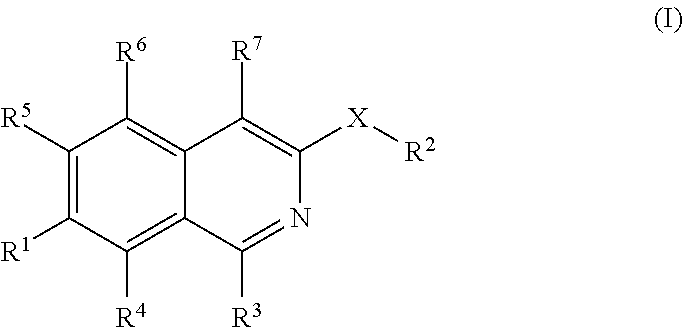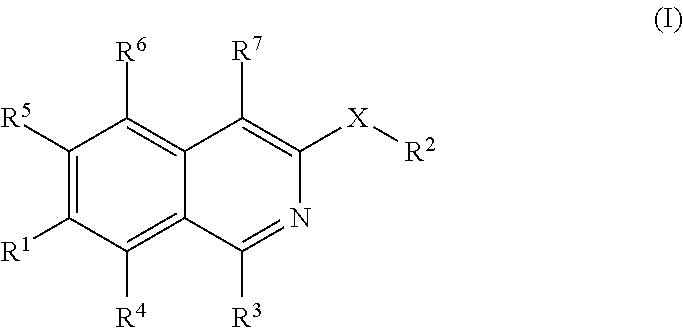Isoquinoline derivatives as perk inhibitors
a technology of isoquinoline and perk inhibitor, which is applied in the field of substituted isoquinoline derivatives, can solve the problems of cell death, inability to synthesize vital proteins, and inability to er redox homeostasis to be disrupted,
- Summary
- Abstract
- Description
- Claims
- Application Information
AI Technical Summary
Benefits of technology
Problems solved by technology
Method used
Image
Examples
example 1
5-(3-Benzylisoquinolin-7-yl)-7-methyl-7H-pyrrolo[2,3-d]pyrimidin-4-amine
[0625]
[0626]Step 1: To a stirred solution of 2-iodobenzoic acid (10.0 g, 40.32 mmol, 1 equiv) in MeOH (100 mL) was added H2SO4 (10 mL) drop wise at 0° C. The reaction mixture was warmed to 90° C. and stirred for 8 hours. The reaction mixture was cooled and concentrated. The residue was basified with saturated sodium bicarbonate at 0° C. and extracted with ethyl acetate (2×150 mL). The organic layer was washed with water and brine solution then dried over sodium sulphate and evaporated to obtain methyl 2-iodobenzoate as colour less liquid (9.0 g, 85%).
[0627]1H NMR (400 MHz, CDCl3) δ ppm 3.93 (s, 3H), 7.15 (t, J=8.0 Hz, 1H), 7.40 (t, J=7.2 Hz, 1H), 7.80 (d, J=8.0 Hz, 1H), 7.99 (d, J=8.0 Hz, 1H).
[0628]Step 2: To a stirred solution of methyl 2-iodobenzoate (5.0 g, 19.08 mmol, 1 equiv) and NBS (3.73 g, 20.99 mmol, 1.1 equiv) in acetic acid (10 mL) was added H2SO4 (10 mL) drop wise at 20-40° C. The reaction mixture wa...
example 2
5-(3-(3,5-Dimethylbenzyl)isoquinolin-7-yl)-7-methyl-7H-pyrrolo[2,3-d]pyrimidin-4-amine
[0634]
[0635]Step 1: To a stirred solution of 4-bromophthalic acid (9.0 g, 37.55 mmol, 1 equiv) in THF (90 mL) was added drop wise BH3.DMS (35 mL, 375 mmol, 10 equiv) at 0° C. The reaction mixture was warmed to room temperature and stirred for overnight. The reaction mixture was cooled and quenched with MeOH slowly then evaporated to obtain crude product which was purified by silica gel flash column chromatography. The compound eluted out in 1.5% MeOH:DCM. The fractions with product were evaporated to obtain (4-bromo-1,2-phenylene)dimethanol as white solid (6.0 g, 75.9%).
[0636]1H NMR (400 MHz, DMSO-d6) δ ppm 4.45 (d, J=5.2 Hz, 2H), 4.51 (d, J=5.2 Hz, 2H), 5.12 (t, J=5.6 Hz, 1H), 5.20 (t, J=11.4 Hz, 1H), 7.31 (d, J=8.0 Hz, 1H), 7.40 (t, J=8.0 Hz, 1H), 7.54 (s, 1H).
[0637]Step 2: A solution of oxalyl chloride (14.2 mL, 165 mmol, 6.0 equiv) in DCM (120 mL) was cooled to −70° C. and DMSO (11.7 mL, 165 mm...
example 3
5-(3-Benzyl-8-fluoroisoquinolin-7-yl)-7-methy-7H-pyrrolo[2,3-d]pyrimidin-4-amine
[0647]
[0648]Step 1: To a stirred solution of 1-bromo-2-fluoro-4-iodobenzene (5.0 g, 16.66 mmol, 1 equiv) in THF (50 mL) was added LDA (8.3 mL, 16.66 mmol, 1.0 equiv) drop wise at −78° C. The reaction mixture was stirred for 1 h and then dry ice was added portion wise at −78° C. The reaction mixture was allowed to warm and stir at room temperature overnight. The reaction mixture was quenched with 1N HCl and extracted with 5% MeOH in DCM (3×60 mL). The organic layer was dried over sodium sulphate, filtered and concentrated to give 3-bromo-2-fluoro-6-iodobenzoic acid (3.5 g, 61.4%) as brown solid. LCMS (ES) m / z=344.0, 346.0 [M+H]+. 1H NMR (400 MHz, DMSO-d6) δ ppm 7.53 (t, J=8.4 Hz, 1H), 7.65 (d, J=8.0 Hz, 1H), 14.18 (s, 1H).
[0649]Step 2: To a stirred solution of 3-bromo-2-fluoro-6-iodobenzoic acid (3.3 g, 9.59 mmol, 1 equiv) in DCM (50 mL) was added SOCl2 (50 mL) drop wise at 0° C. The reaction mixture was ...
PUM
| Property | Measurement | Unit |
|---|---|---|
| Mass | aaaaa | aaaaa |
| Mass | aaaaa | aaaaa |
| Mass | aaaaa | aaaaa |
Abstract
Description
Claims
Application Information
 Login to View More
Login to View More - R&D
- Intellectual Property
- Life Sciences
- Materials
- Tech Scout
- Unparalleled Data Quality
- Higher Quality Content
- 60% Fewer Hallucinations
Browse by: Latest US Patents, China's latest patents, Technical Efficacy Thesaurus, Application Domain, Technology Topic, Popular Technical Reports.
© 2025 PatSnap. All rights reserved.Legal|Privacy policy|Modern Slavery Act Transparency Statement|Sitemap|About US| Contact US: help@patsnap.com



